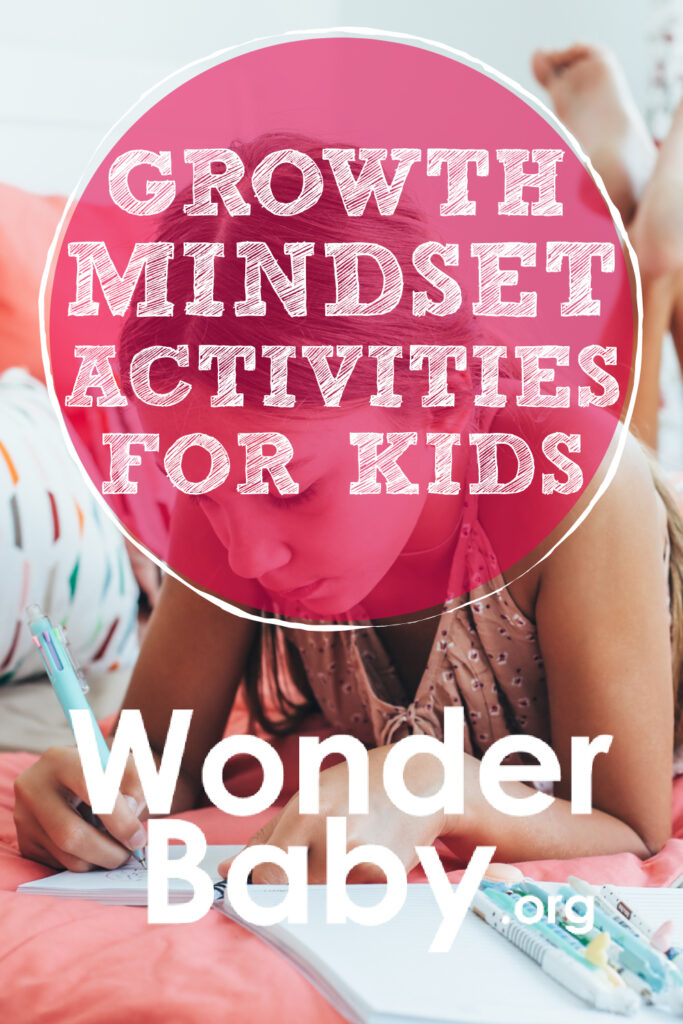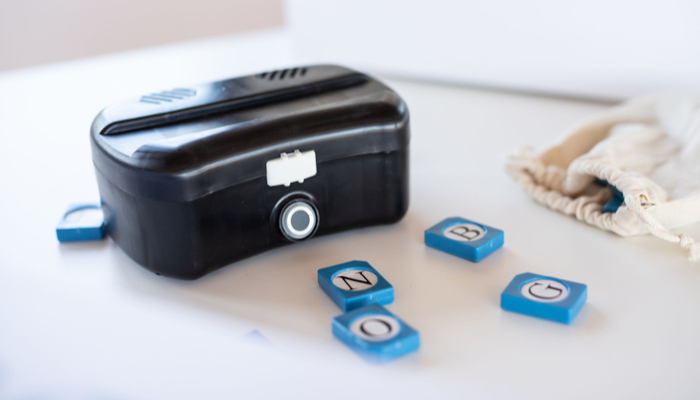5 Growth Mindset Activities for Kids

This post may contain affiliate links; please see our terms of use for details.
- Growth mindset activities are great for helping kids with perseverance, self-awareness, increased self-esteem, and resilience.
- Growth mindset activities help teach kids to deal with negative feelings they may have around mistakes or failures and understand how to see these as learning opportunities instead.
- You can teach growth mindset at home with simple activities that encourage kids to take on challenges, learn from mistakes, celebrate their achievements, and help them set goals for success.
- The best growth mindset activities also challenge you as a parent to view your child’s struggles and mistakes as part of their learning process for future success.
Growth mindset is a concept first coined by psychologist Carol Dweck. Dweck’s research focused on how students’ perception of their ability can affect their achievement. She found that students who believed that their intelligence was a trait that could be developed and worked on to become stronger over time had what she called a growth mindset.
Students who looked at themselves this way outperformed those students who believed intelligence was something they’re born with that can’t ever be changed—a fixed mindset. Students who believed they could “grow their brains” by trying new strategies, working hard, and making mistakes achieved more than those with a fixed mindset.
This theory has been adopted by educators all over the world to encourage students, but how can you help your child work on their growth mindset at home? These growth mindset activities for kids will help children develop, increase their self-confidence, and embrace challenges as they learn.
Activity 1: Guess the Mindset

To help your kids get the hang of growth mindset11. Dweck, C.. Carol Dweck Revisits the ‘Growth Mindset.’ . Education Week. 2015. https://www.edweek.org/leadership/opinion-carol-dweck-revisits-the-growth-mindset/2015/09 and what it’s all about, try this simple game.
On index cards write down some growth mindset statements like:
- Let me try a different way.
- What can I do better next time?
- I like a challenge.
- Mistakes help me learn.
- Did I do my best work?
Then write down some fixed mindset phrases on other cards such as:
- I can’t do this.
- I failed.
- New things are too hard to do.
- I’m not good at this.
- I’m all done.
Explain growth mindset to your kids. Then have your children go through the phrases one by one, either with you or on their own, to sort them into a growth mindset pile and a fixed mindset phrase pile.
Talk about which phrases go in which pile and why. Ask your kids which of these phrases they might say to themselves and when. Encourage a discussion about how to change to growth mindset messages when they encounter something that’s hard to do or when they make a mistake.
Activity 2: Growth Mindset Journal

There are many ways to use a journal to help children embrace the growth mindset22. Cornwall, G.. How to Instill a “Growth Mindset” in Kids. U.S. News.. 2022. https://www.usnews.com/education/k12/articles/how-to-instill-a-growth-mindset-in-kids perspective. Journals can be used to:
- Set goals and the steps your child can take to meet them, as well as document the results.
- Give your kids some growth mindset words as a prompt to write or draw about, like courage, perseverance, teamwork, and resilience.
- Give your kids space to vent frustrations they might have and to think about ways they can change strategies.
- Find inspirational quotes and ask your children to write about what they mean to them.
- List positive affirmations that your kids can refer back to.
Journaling is a great habit to get into. It encourages self-expression as well as helping children hone their writing skills. If journaling is something you also do, consider setting aside family journal time when you can all write together.
If coming up with journaling activities feels like too much work, there are some great guided growth mindset journals on the market, like Big Life Journal For Kids for ages 7 to 10. The Big Life Journal publishers also make a teen edition as well as one for adults.
- CREATE CONFIDENT KIDS: This growth mindset workbook for kids teaches children age 7-10 to believe in themselves and face challenges with confidence.
- POSITIVE PSYCHOLOGY: The inspirational kids journal with prompts shows that mistakes are an opportunity to grow, and that with a positive kid’s mindset, they can achieve anything if they are persistent!
- SHARE & CONNECT: Complete the interactive journal’s fun activities and writing prompts with a journal buddy e.g. a parent or grandparent who will love their special time sharing ideas, stories and conversations.
- JOURNAL & PODCAST: The Big Life Kids Podcast accompanies the guided journal for kids, for a multisensory learning experience. The free podcast is available from multiple sources including iTunes and Spotify.
- EMPOWER TEENS & TWEENS: This growth mindset workbook encourages children age 11+ to dream about their future. The guided journal for teens and tweens helps them develop resilience, gratitude and positivity.
- POSITIVE PSYCHOLOGY: Show teens the power of their own mind – this is a writing journal for teens to learn the importance of self-talk and how their mindset is shaped by their thoughts.
- TURN DREAMS INTO GOALS: The inspirational teen journal allows them to dream up their future life and the goal planner shows how to turn their BIG dreams into a series of achievable goals.
- DISCOVER INTERESTS: With fun activities and writing prompts, this is an engaging interactive journal for teens to discover their true interests – it’s the teen and tween journal they will want to use!
- CULTIVATE POSITIVE SELF-TALK: Learn to recognize your negative thought patterns that are stopping you from creating the life you want.
- BREAK FREE FROM SELF-SABOTAGE: Gain the tools to break free from constant cycles of negative thoughts, feelings of regret, and hopelessness so that you can finally move from ‘who am I to do this?’ to ‘I can do this!’
- INCREASE YOUR SELF-ESTEEM: Practice science-based personal development strategies to let go of self-doubt, negativity, stress, and procrastination and find the motivation to pursue your dreams, set personal goals, and keep track of them.
- CREATE THE LIFE YOU WANT: Develop the mindset you need to fearlesslyl pursue the life you’ve always wanted. Learn how to take charge of your life and stop caring what others think.
Activity 3: Famous Fails

One of the most important concepts when teaching growth mindset is that mistakes are part of learning. Fixed mindsets see mistakes as failures. Fear of failure can then lead some people to stay away from challenges and make them reluctant to try or learn new things. They avoid difficult tasks because they fear getting the answer wrong or not winning.
Engage your kids in a discussion about failure by having them look up famous people and their famous failures. The following are great examples:
- Steve Jobs
- Oprah Winfrey
- Walt Disney
- Michael Jordan
- Barack Obama
- Albert Einstein
Your kids can write down their thoughts about these stories of successful people in their journals. Or, they can make a poster all about these famous fails.
You can also expand this activity for kids with ADHD or dyslexia to highlight the many famous people and historical figures, from actors to scientists, who have dealt with those issues along their journeys.
Encourage your kids to discuss the histories of these exceptional people and how they each used a growth mindset to overcome their mistakes and challenges to reach success.
Activity 4: The Power of “Yet”

“Yet” is a powerful word in the growth mindset dictionary. When children encounter a challenge that they can’t surmount on the first, second, or even the tenth try, the power of “yet” lets them know that it’s still possible to succeed.
For example, if your child struggles with math, you might catch yourself saying “Oh, she’s just not a math person,” or your child might say, “I just don’t get math.” However, when you add “yet” to the end of those sentences, possibility suddenly opens up and a fixed mindset statement changes into a tool for personal growth.
“Oh, she’s just not a math person, yet,” and “I just don’t get math, yet,” lead to growth-oriented thinking instead of feeling defeated or discouraged by a challenge.
Make a “Yet” poster with your child that they can hang in their room. It can be just the word “Yet” which they can decorate any way they want to and look at it for inspiration when they feel discouraged.
Or they can write or draw some goals on the poster for things that they can’t do yet or haven’t learned yet. Revisit those goals with them from time to time and celebrate the progress that they’ve made.
Activity 5: Glow and Grow

When your child has demonstrated a growth mindset by setting a goal, putting the effort in, and achieving something, it’s important to celebrate that success.
One fun way of celebrating achievements and everyday small successes while also thinking about growth and progress is to do a Glow and Grow activity.
The idea behind Glow and Grow is to have your child acknowledge the amazing things they’ve done while also thinking about the areas where they could improve or need to do more work.
You can do Glow and Grow in a couple of different ways:
- At the end of the day, for example, at dinnertime, have everyone in the family say one area where they glowed and one where they could grow.
- Have your kids write their Glow and Grow on a chart, in their journal, or on a pre-printed worksheet you can hang on the fridge or in their room.
- At bedtime, encourage your child to think about the day and have them tell you their Glow and Grow. Add to what they’ve said about themselves, and contribute your own Glow and Grow for your own day.
Whether you do this growth mindset activity verbally or as a writing or visual task, the point is to help children learn to develop a growth mindset through positive reinforcement of what they’ve done well. It will also encourage kids to look at the things that challenge them as opportunities for learning rather than as overwhelming or frightening.
FAQs
How can parents or caregivers reinforce growth mindset principles outside of structured activities?
There are many opportunities throughout the day with your child to reinforce growth mindset ideas.
Take the playground, for example. If your child is struggling to climb the jungle gym and says, “I can’t do it!” try reframing the problem for them. Give them some physical support and say something like, “Well, if it’s not working going that way, let’s try a different way.”
If they go up the jungle gym part of the way, congratulate them for their effort and trying a different strategy. If they’re too afraid to reach for the top, or it’s too difficult for them, try using the language of “yet”: “You didn’t reach the top yet, but we’ll try again another day.”
There are also many fantastic books on the market all about growth mindset for children. Try out some of these at storytime or bedtime:
- Hardcover Book
- Pett, Mark (Author)
- English (Publication Language)
- 32 Pages – 10/01/2011 (Publication Date) – Sourcebooks Jabberwocky (Publisher)
- Hardcover Book
- Santat, Dan (Author)
- English (Publication Language)
- 40 Pages – 10/03/2017 (Publication Date) – Roaring Brook Press (Publisher)
- Hardcover Book
- Jones, Charlotte Foltz (Author)
- English (Publication Language)
- 96 Pages – 10/11/2016 (Publication Date) – Delacorte Press (Publisher)
It’s also important to remember that growth mindset isn’t just for kids to help them with their schoolwork. Children learn the most from our example. Being a role model of growth mindset for your child is the best way to teach them how to deal with mistakes, rise to challenges, and change strategies when trying to solve problems.
References
- Dweck, C. (2015, September 22). Carol Dweck Revisits the ‘Growth Mindset.’ Education Week. https://www.edweek.org/leadership/opinion-carol-dweck-revisits-the-growth-mindset/2015/09
- Cornwall, G. (2022, April 14). How to Instill a “Growth Mindset” in Kids. U.S. News. https://www.usnews.com/education/k12/articles/how-to-instill-a-growth-mindset-in-kids

Related Posts

IEPs
What Should I Bring to My Child’s First IEP Meeting?
Prepare for your child's first IEP meeting with confidence! Discover exactly what documents to bring, including educational records, medical info, and questions to ask.

Braille and Literacy
Making Braille Fun: Introducing Handi Exceller’s Innovative Learning Tools for Blind Students
Handi Exceller was born from a simple idea: learning braille should be both fun and accessible. The company creates interactive and gamified ways to teach braille.

Braille and Literacy, Toys, Visual Impairment
24 Braille Toys for Kids Who are Blind
Everything from alphabet blocks to raised line coloring pages and activity books to puzzles to card and board games... and so much more! And it's all in braille ready for...





